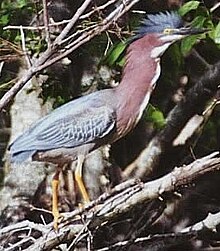
Back بوتوريد ARZ Zenki (Butorides) AVK Butorides Breton Butorides Catalan Butorides CEB Butorides German Butorides Esperanto Butorides Spanish Kyyryhaikarat Finnish Butorides French
| Butorides Temporal range: Early Pleistocene to present
| |
|---|---|

| |
| Green heron (Butorides virescens) | |
| Scientific classification | |
| Domain: | Eukaryota |
| Kingdom: | Animalia |
| Phylum: | Chordata |
| Class: | Aves |
| Order: | Pelecaniformes |
| Family: | Ardeidae |
| Subfamily: | Ardeinae |
| Genus: | Butorides Blyth, 1852 |
| Type species | |
| Ardea javanica[1] Horsfield, 1821
| |
| Species | |
Butorides is a genus of small herons. It contains three similar species: the green heron or green-backed heron, Butorides virescens, the lava heron (Butorides sundevalli), and the striated heron, Butorides striatus. A fossil species, Butorides validipes, is known from the Early Pleistocene of Florida in the United States. Butorides is from Middle English Butor "bittern" and Ancient Greek -oides, "resembling".[2]
Adults of both extant species are about 44 centimetres (17+1⁄2 inches) long, and have a blue-black back and wings, a black cap, and short yellow legs. Juveniles are browner above and streaked below, and have greenish-yellow legs.
The species have different underpart colours: chestnut with a white line down the front in green herons, and white or grey in striated. Both breed in small wetlands on a platform of sticks, often in shrubs or trees, sometimes on the ground. The female lays three to five eggs. Both parents incubate for about 20 days until hatching, and feed the young birds, which take a further three weeks to fledge.
Butorides herons stand still at the water's edge and wait to ambush prey. They mainly eat small fish, frogs and aquatic insects. They sometimes drop food on the water's surface to attract fish.
- ^ "Ardeidae". aviansystematics.org. The Trust for Avian Systematics. Retrieved 2023-07-27.
- ^ Jobling, James A (2010). The Helm Dictionary of Scientific Bird Names. London: Christopher Helm. p. 81. ISBN 978-1-4081-2501-4.